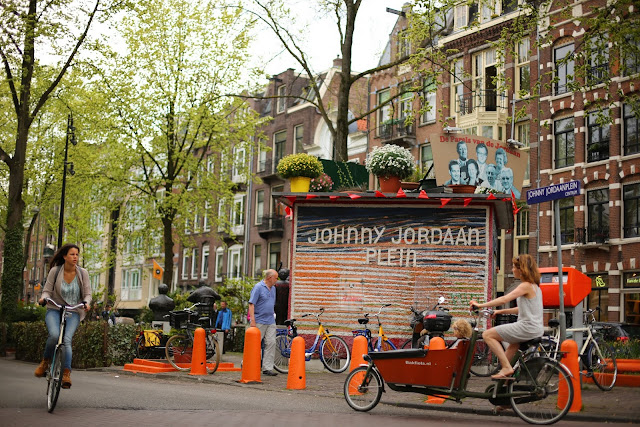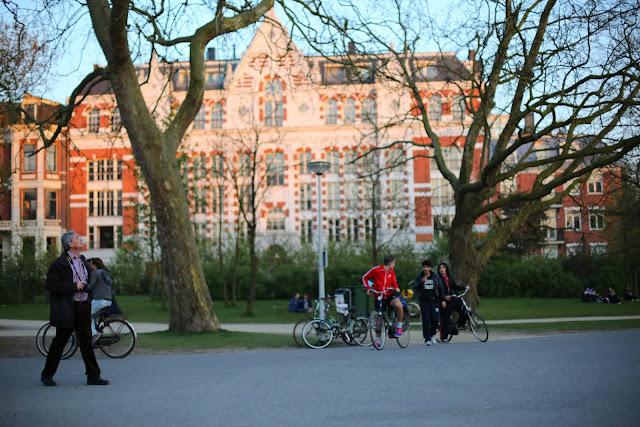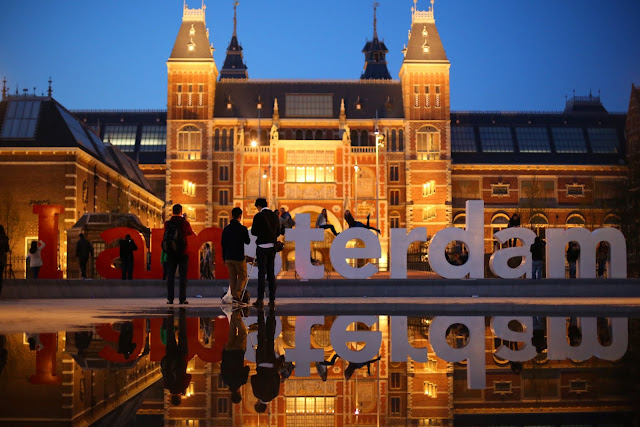Spring in Amsterdam is always one of my favorite times of the year - usually marked by Queen's Day on April 30th. With the beginning of spring, this means the days are finally getting longer, people can stay and linger on the terraces, and the weather is warm enough for people to bike throughout the city.

As any visitor has experienced, bikes rule the roads in Amsterdam, and much of the Netherlands. The entire transit system is optimized for bike traffic: there are dedicated bike paths that run next to major roads, and if not, there are separately marked bike lanes on the streets. For the most part, bikes and cars share the road, although in my opinion, I think you'd be crazy to drive in Amsterdam given the volume of bike traffic. In fact, along some of the major intersections, because of the volume of bikes going with traffic, cars that are making a left or right turn often have to wait several cycles of the stoplight before being able to turn, due to all the bikes crossing. It's almost like the cars need a protected left/right arrow from the bikes!

Dutch bikes are built very differently from the styles normally seen in the US, and they're quite practical in design for weather and utility. For the wet/rainy weather, there's always a splash guard behind the front and back wheels, and there's also a covered chain so that you can bike into work in your suit without worrying about your pants getting stained by oil. For the brakes, instead of a disc brake along the wheelrim, there's an integrated brake hub that's connected to the axle. I assume this is to provide better braking performance when the wheels are wet, since the braking mechanism is sealed instead of exposed.
For utility, these bikes are designed for comfort and convenience. You'll first notice that the handlebars are curved, allowing the rider to sit straight upright, without "hunching". It increases drag, so definitely not good for sport racing, but it is comfortable for long bike rides of 20-30 minutes. Almost all bikes will have rear rack for carrying groceries, beer crates, or sometimes even crazier things like desks, computer monitors, even chest of drawers! With HS's help, we actually attached my heavy rollerbag onto my bike once, and successfully brought it from the train station to my house. Imagine, about 25 pounds of luggage strapped onto one side of my bike, and it was still balanceable!
For young mothers, there's also the
baksfiets, which looks like something you'd expect on a farm, like a cross between a bike and a wheelbarrow. It's a bike with a huge "scoop" in the front (the
bakje, or small container), where you can put the kids into the front. And in case of rain, there's a cover than can pull over their heads. If you're a young family living in the city, instead of a minivan, you get a
bakfiets.

Besides the bikes, the nice spring weather makes for great walking-around weather. One of my favorite places to bike through is the huge Vondelpark, something like Central Park for Amsterdam. It's a huge open green space, surrounded by huge trees and amazing tall houses which are probably some of the most expensive addresses in Amsterdam. THe park is filled with huge paths for walking, biking, running, roller-blading. As the days get longer and the summer weather begins, the park gets filled with people enjoying a barbeque, playing cards, pick-up game of soccer, etc. I always enjoyed biking through the Vondelpark instead of taking the parallel streets when going between my old apartment and the center.. not only do you avoid traffic, but it's a great place to people watch, either from the park, or from the few cafes with terraces overlooking the park. Whether just enjoying a coffee and reading my Economist, or meeting up with friends for a drink, the Vondelpark is a great place just to relax and enjoy the outdoors.


The other advantage of the beginning of spring in Amsterdam is the long/late evenings.. this means that the sunsets start around 8pm and start to go later, and the city becomes very beautiful right around sunset, with the combination of the interior lights coming on just as dusk begins. Amsterdam houses (and maybe Europe in general) frequently have extremely large windows. I was never quite sure of the reason why, maybe because it allows as much light in as possible during the winter months where there's only 6-7 hours of sunlight? Or because the Dutch enjoy their openness, allowing everything inside to be seen from the outside? Or because the old canal houses have very narrow staircases, and thus having large windows are necessary to bring furniture in through the windows instead of the staircases? Either way, it makes for an amazing scene - seeing the warm glow from an interior room with ~15-20 foot ceilings just as sunset begins.



But of the best things about the spring and summer is the chance to enjoy a nice refreshing snack. In the
Jordaan and throughout the city, there's a local chain of shops called "
Yscupje", or "little ice cup", which sells excellent self-made ice creams and sorbets.
The location in the Jordaan is particularly nice, as you can enjoy a cup
of ice cream while sitting on the side of the canal surrounded by the canal houses, and watch the
boats (and tourists) go by....
And for those looking for something less sweet, there's plenty of places to enjoy a drink - either going through the Heineken experience (not that I've ever done it, because it's too touristy), or finding a nice bier cafe (like Gollem on Overtoom), where you can enjoy a drink with a view of the street. And nothing better than meeting with friends and enjoying a drink from a local Amsterdam brewery "
Brouwerij 't IJ". When are they going to start importing to the US?!



